Gardner Creek (Susquehanna River tributary)
Gardner Creek (also known as Gardiners Creek or Gardners Creek) is a tributary of the Susquehanna River in Lackawanna County, Pennsylvania, in the United States. It is approximately 9.1 miles (14.6 km) long and flows through Newton Township and Ransom Township. The watershed of the creek has an area of 18.1 square miles (47 km2). The creek is not designated as an impaired waterbody. The surficial geology in its vicinity mainly consists of alluvial terrace, alluvium, Wisconsinan Till, and bedrock. However, Wisconsinan Ice-Contact Stratified Drift, fill, alluvial fan, peat, and wetlands also occur. The creek is the main source of flooding in Ransom Township. The area at the mouth of Gardner Creek was settled as early as 1769. A number of mills, including a sawmill and a gristmill, were constructed on the creek in the early 19th century. Numerous bridges were built over it in the 20th century. The creek experienced streambank erosion during Tropical Storm Agnes in 1972. It is designated as a Coldwater Fishery and a Migratory Fishery. Wild trout naturally reproduce within it.
Excerpt from the Wikipedia article Gardner Creek (Susquehanna River tributary) (License: CC BY-SA 3.0, Authors).Gardner Creek (Susquehanna River tributary)
Cheryl Lane, Ransom Township
Geographical coordinates (GPS) Address Nearby Places Show on map
Geographical coordinates (GPS)
| Latitude | Longitude |
|---|---|
| N 41.3882 ° | E -75.8187 ° |
Address
Cheryl Lane
18653 Ransom Township
Pennsylvania, United States
Open on Google Maps




